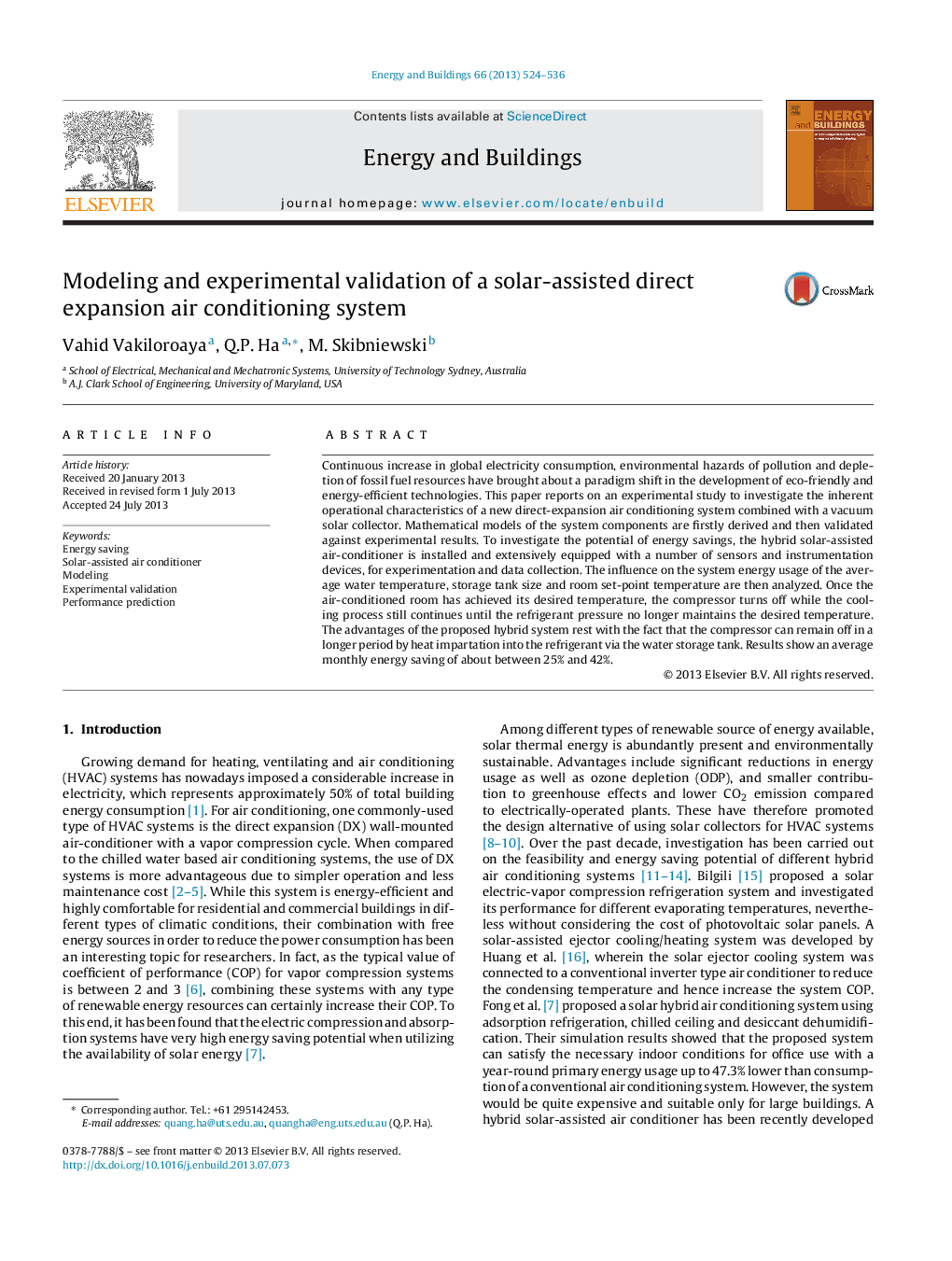| کد مقاله | کد نشریه | سال انتشار | مقاله انگلیسی | نسخه تمام متن |
|---|---|---|---|---|
| 6734763 | 504072 | 2013 | 13 صفحه PDF | دانلود رایگان |
عنوان انگلیسی مقاله ISI
Modeling and experimental validation of a solar-assisted direct expansion air conditioning system
ترجمه فارسی عنوان
مدل سازی و اعتبار سنجی تجربی یک سیستم تهویه مطبوع گسترش مستقیم مستقر در خورشید
دانلود مقاله + سفارش ترجمه
دانلود مقاله ISI انگلیسی
رایگان برای ایرانیان
کلمات کلیدی
ذخیره انرژی، تهویه مطبوع با کمک خورشیدی، مدل سازی، اعتبار تجربی، پیش بینی عملکرد،
ترجمه چکیده
افزایش مداوم در مصرف برق جهانی، خطرات زیست محیطی آلودگی و کاهش منابع سوخت فسیلی موجب تغییر پارادایم در توسعه فن آوری های سازگار با محیط زیست و انرژی می شود. این مقاله در یک مطالعه تجربی به منظور بررسی ویژگی های عملیاتی ذاتی یک سیستم تهویه مطبوع جدید با پیمایش جدید همراه با یک گردآورنده خلاء خورشیدی گزارش شده است. مدل های ریاضی اجزای سیستم ابتدا مشتق شده و سپس در مقابل نتایج تجربی تأیید می شوند. برای بررسی پتانسیل صرفه جویی در انرژی، هیبرید تهویه مطبوع با کمک خورشیدی نصب شده است و به طور گسترده ای با تعدادی از سنسورها و دستگاه های ابزار، برای آزمایش و جمع آوری داده ها مجهز شده است. تأثیر در استفاده از انرژی سیستم از درجه حرارت متوسط آب، اندازه مخزن ذخیره سازی و دمای اتاق تنظیم شده است. هنگامی که اتاق تهویه مطبوع دمای مورد نظر خود را به دست آورده است، کمپرسور خاموش می شود در حالی که فرایند خنک کننده همچنان ادامه می یابد تا فشار مبرد دیگر دمای مورد نظر را حفظ نکند. مزایای استفاده از سیستم ترکیبی پیشنهاد شده با این واقعیت است که کمپرسور می تواند در یک دوره طولانی با قرار دادن گرما در مبرد از طریق مخزن ذخیره سازی آب خاموش شود. نتایج نشان می دهد که متوسط صرفه جویی در انرژی ماهانه بین 25٪ تا 42٪ است.
موضوعات مرتبط
مهندسی و علوم پایه
مهندسی انرژی
انرژی های تجدید پذیر، توسعه پایدار و محیط زیست
چکیده انگلیسی
Continuous increase in global electricity consumption, environmental hazards of pollution and depletion of fossil fuel resources have brought about a paradigm shift in the development of eco-friendly and energy-efficient technologies. This paper reports on an experimental study to investigate the inherent operational characteristics of a new direct-expansion air conditioning system combined with a vacuum solar collector. Mathematical models of the system components are firstly derived and then validated against experimental results. To investigate the potential of energy savings, the hybrid solar-assisted air-conditioner is installed and extensively equipped with a number of sensors and instrumentation devices, for experimentation and data collection. The influence on the system energy usage of the average water temperature, storage tank size and room set-point temperature are then analyzed. Once the air-conditioned room has achieved its desired temperature, the compressor turns off while the cooling process still continues until the refrigerant pressure no longer maintains the desired temperature. The advantages of the proposed hybrid system rest with the fact that the compressor can remain off in a longer period by heat impartation into the refrigerant via the water storage tank. Results show an average monthly energy saving of about between 25% and 42%.
ناشر
Database: Elsevier - ScienceDirect (ساینس دایرکت)
Journal: Energy and Buildings - Volume 66, November 2013, Pages 524-536
Journal: Energy and Buildings - Volume 66, November 2013, Pages 524-536
نویسندگان
Vahid Vakiloroaya, Q.P. Ha, M. Skibniewski,
